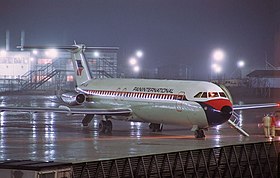Paninternational flight 112
| Paninternational flight 112 | |
|---|---|
|
The Paninternational D-ALAR aircraft involved in the accident at Stockholm / Arlanda Airport in December 1970 |
|
| Accident summary | |
| Type of accident | unsuccessful landing after a double engine fire |
| location |
Motorway A7 near Hasloh , Schleswig-Holstein , FR Germany |
| date | September 6, 1971 |
| Fatalities | 22nd |
| Survivors | 99 |
| Injured | 45 |
| Aircraft | |
| Aircraft type |
|
| operator |
|
| Mark |
|
| Departure airport |
Hamburg Airport , BR Germany |
| Destination airport |
Malaga airport , Spain |
| Passengers | 115 |
| crew | 6th |
| Lists of aviation accidents | |
On Monday, September 6, 1971, a BAC 1-11 of the German airline Paninternational crashed on Paninternational flight 112 ( flight number DR112 ) shortly after taking off from Hamburg Airport during an emergency landing on the A7 motorway near Hasloh, which is under construction . The machine with the aircraft registration D-ALAR was to make a charter flight to Málaga . Of the 121 inmates, 22 were killed; 45 people were injured, some seriously.
Flight history
The twin-engine aircraft , fully occupied with 115 passengers and six crew members, took off at 6:19 p.m. from runway 34 in Hamburg-Fuhlsbüttel with destination Málaga . A few minutes after take-off, both Rolls-Royce-Spey engines caught fire. Captain Reinhold Hüls and copilot Elisabeth Friske , who died in a plane crash in Lübeck with Uwe Barschel on board in May 1987 , managed to set up the machine near Hasloh on a section of the A7 motorway that was under construction . The left landing gear broke and the machine turned to the left. When passing through a highway overpass the village road at kilometers 138.3 was rudder pulled down and the cockpit by a bridge abutment at 53 ° 42 '10.1 " N , 9 ° 56' 33.4" O from the hull separated, wherein a crew member and 17 Passengers were killed instantly. Four seriously injured people later died in hospital. People on the ground were not harmed. The rest of the fuselage with the wings came to a stop on the highway embankment, rotated 180 degrees.
Aircraft accident investigation
The cause of the simultaneous failure of both engines was found to be that the water injection tanks for the turbines contained not only water but also flammable kerosene . To allow a fully loaded machine to take off safely, demineralized water was injected into the engines during take-off to increase the thrust for a short time to increase the air density and thus increase fuel consumption.
The investigations showed that during repair work at Düsseldorf Airport, an employee from Paninternational filled 100 liters of kerosene into two 60-liter canisters, which were then moved to the warehouse by an aircraft electrician and later from the accident machine along with three other canisters of pure water to Hamburg were taken. When the tanks of the water injection system were to be refilled there the next day, the copilot had the contents of the five canisters pumped into the tanks. The copilot dismissed the warning from an employee that it stank of fuel with the remark: "Everything stinks of fuel here". Since kerosene is specifically lighter than water, first the water below and then the kerosene was injected during take-off, which led to overheating and a fire in both engines.
It was also found that the shifts of the maintenance staff in Düsseldorf overlapped without clearly defining their responsibilities. This was seen as a reason that the overview of water and kerosene containers had been lost. In the Bundestag , there were also allegations against Karl Wienand , who, as parliamentary manager of the SPD , is said to have protected the airline from inspections by the Federal Aviation Office for years in return for an “advisory fee” .
See also
- Southern Airways flight 242 with a Douglas DC-9 , which also crashed on April 4, 1977 while making an emergency landing on a highway.
Web links
- Emergency landing on the A7 near Hasloh / Hamburg in 1971 on YouTube (report with a survivor, a helper and the pilot).
- The day on which ... an emergency landing on the A 7 ended in a catastrophe
literature
- Helmut Kreuzer: Crash - The fatal accidents with passenger aircraft in Germany, Austria and Switzerland (since 1950) . 1st edition. Air Gallery Edition, Erding, 2002, ISBN 3-9805934-3-6 .
Individual evidence
- ↑ Accident report BAC 1-11-500 D-ALAR , Aviation Safety Network (English), accessed on March 6, 2019.
- ↑ At the time of the accident, the railway was using the identification number 16/34. It was not until the beginning of the 1980s that the identifier was changed to 15/33 due to the changing location dismissal.
- ↑ Death in the Cornfield . In: Der Spiegel . No. 24 , 1987, pp. 201-202 ( online ).
- ↑ G / L account 48002 . In: Der Spiegel . No. 11 , 1972, p. 82 ( online ).
- ↑ Head down! In: Der Spiegel . No. 12 , 1972, p. 32-34 ( online ).
Coordinates: 53 ° 42 ′ 10 ″ N , 9 ° 56 ′ 32.9 ″ E
